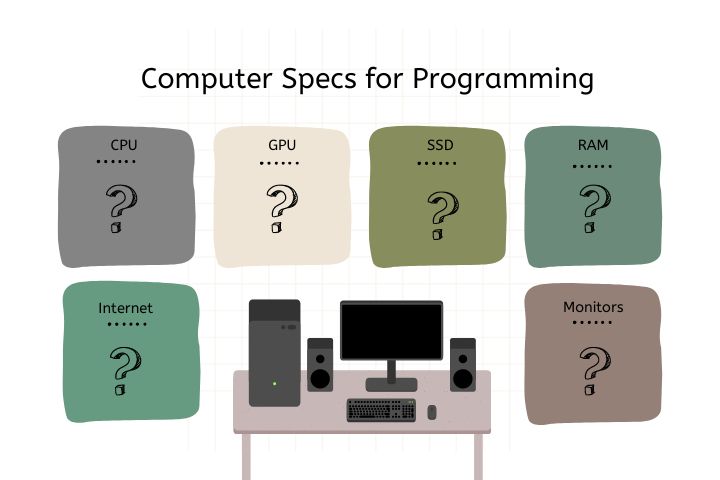Computer Specs for Programming
When it comes to computers, there are a lot of variables that can affect performance. This can be frustrating for new programmers who are trying to determine what type of computer they need to run the programs they want without any lag. In this blog post, we will go over the minimum computer specs you need for programming to help set your mind at ease.

What Computer Specs Do I Need for Programming?
Processor (CPU)
The processor is going to be one of the most important components of programming. A lot of newer processors on the market are more than capable of handling basic programming tasks.
However, if you want to do more intensive things or use more demanding software, you’re going to want to make sure you have a processor that can handle it. We recommend at least an Intel Core i5 processor or its AMD equivalent.
RAM
RAM, or random access memory, is an important component of any computer, especially if you’re planning on doing any kind of programming. The main reason for this is that programming often requires running multiple programs at the same time, and RAM helps your computer to do this without slowing down.
Additionally, some programming languages can be quite memory intensive, so if you’re planning on doing any data-heavy work, we recommend getting 16GB of RAM. While you can get by with less RAM, it’s always better to err on the side of caution when it comes to such an important piece of equipment. After all, your computer is only as good as the components you put into it.
Graphic card (GPU)
A lot of people overlook the importance of a good GPU when it comes to programming. However, if you’re planning on doing any kind of 3D work or graphics-intensive programming, you’re going to want a good one. We recommend at least an NVIDIA GTX 1060 or its AMD equivalent.
And GPUs are important for two main reasons when it comes to game development. They help improve the visual quality of games by rendering complex graphics quickly and smoothly. They can also be used to accelerate certain tasks, such as physics simulations and AI processing.
If you’re interested in game development or graphic-intense work, you’ll want to make sure your computer has a good GPU.
Storage
When it comes to storage, you’re going to want to make sure you have enough space for all the programs and files you’ll need for programming.
Most new computers come with at least 1TB of storage these days, which should be plenty for most people. However, if you know you’ll need more than that, you can always opt for an upgrade.
Most prefer SSDs over HDDs because they’re much faster, but they can be more expensive. If you’re on a budget, an HDD will still work just fine for most programming tasks.
Internet speed
This one might seem obvious, but it’s worth mentioning. A fast internet connection is important for programming for a few reasons.
You’ll need to be able to download any programs or files you need quickly. If you’re working with other people or collaborating on projects, a fast internet connection will make things a lot smoother.
High-resolution monitors
When it comes to monitors, the resolution is everything. A higher resolution means a sharper image, which is especially important when you’re working with text or doing any kind of design work. For that reason, we always recommend monitors with a full 1920x1080p HD resolution.
The extra pixels make a big difference, and you’ll be glad you have them when you’re trying to read small text or make out fine details. And while you may think that 1920×1080 is only really useful for things like streaming movies in 4K or playing games, it has a lot of other benefits as well.
For one thing, it makes it much easier to multitask, as you can fit more information on the screen at once. And if you ever need to connect your laptop to an external monitor, a higher resolution will make the transition seamless.
Multiple monitors are becoming increasingly popular, especially among programmers. The main reason for this is that they allow you to have more than one program open at a time and view them side by side.
This can be extremely helpful when you’re trying to debug code or compare two different pieces of code. It’s also just generally convenient to be able to see everything you need in one place without having to constantly switch between windows.
If you’re serious about programming, we recommend investing in at least two monitors.
Now that we’ve gone over the minimum computer specs you need for programming, you should have a better idea of what type of machine you need to get the job done.
Of course, if you’re just starting, you don’t need to go out and buy the most expensive computer on the market. Just make sure it meets the minimum requirements we listed above and you’ll be fine.
These are just the basic requirements for programming. Of course, if you want to get more into depth or use more demanding software, you might need to upgrade some of your hardware. But for most people, the specs we’ve listed should be more than enough.